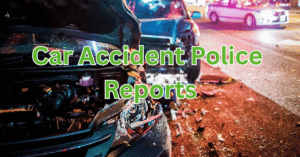Utah Car Accident Police Reports: Everything You Need to Know
A police report records key crash facts that insurance adjusters read first. In Utah, you can request it online or from the local agency. If details are wrong, ask for a correction or add a statement with proof.
Right after a crash, you need facts, not guesswork. A police report is a simple way to lock in what happened, who was involved, and where the damage was. It helps insurance, shows the timeline, and preserves witness notes. In Utah, reports follow a standard format that officers use across the state.
You can request a copy, read it line by line, and fix errors you spot. This guide explains when a report is required, how to get one, how to read the Utah DI-9 form, what a sample layout looks like, and how to dispute mistakes.
We will use Utah rules and agency steps so you are not left searching. In case you have questions, speak with a local car accident attorney who knows how insurers use these reports.
Key Points You Should Know
- Injury, death, or high damage triggers reporting
- Get reports from state or local records
- Utah crash form is the DI-9
- Codes explain events and conditions
- You can fix factual errors
- Officers rarely change opinions
- Insurance leans on report details
- Keep copies for your claim timeline
Do I Need a Police Report For a Minor Crash in Utah?
Not every fender bender needs an officer at the scene, but Utah law sets clear triggers. If anyone is hurt, if there is a death, or if property damage appears to be at least $2,500, the crash must be reported.
Officers who investigate must file the electronic report with the state within 10 days after finishing their investigation. The Department of Public Safety can also require drivers to file a report within 10 days of the state’s request. That report became part of the statewide crash record. These rules matter even for what seems like a small hit in a parking lot.
How To Get a Copy of Your Utah Crash Report?
Start by asking which agency handled your crash. On highways and many state roads, the Utah Highway Patrol responds. If you wish to obtain a copy of the crash report for a specific crash, you can do so by visiting the Utah Department of Public Safety’s Public Records Portal under GRAMA.
Upon the release of the digital copy, you will be able to order it online. Police departments and sheriff’s offices can provide your police report in case of city or county crashes. Many agencies let you submit GRAMA requests online. Fees are modest and vary by agency. For example, Salt Lake City lists a $10 charge for traffic accident reports up to 50 pages.
Some sheriff’s offices sell reports through Crashdocs by Carfax. Reports are protected records in Utah and go to people allowed by law, such as involved drivers, their insurers, and attorneys. Plan for a short wait while the officer finishes and the report is approved. Many departments say 3 to 5 business days, but complex cases can take longer.
Some Utah car accident attorneys will request the report for clients as part of the claim setup.
How To Read a Utah DI-9 Police Report?
Utah officers use a standard crash form called the DI-9. It looks dense at first, but it tells a clear story in numbered boxes and check fields. Near the top you will see date, time, exact location, road type, and light and weather conditions. Each vehicle has its own section with the driver’s info, insurer, vehicle damage area, and whether a citation was issued. There is a small diagram space where the officer draws paths of travel and point of impact.
You will also see coded boxes for the sequence of events. Those codes show what happened first, second, and so on, such as rear-end, sideswipe, or a non-collision event like running off the road.
Other boxes cover restraints, airbags, child seats, and injury levels. The narrative section ties it all together in plain words, listing witness names and what people said happened. Once you understand that codes and boxes match the diagram and the narrative, you can move through the report with confidence. Keep notes of anything that seems off so you can request a fix.
Source: Highwaysafety Utah
Car Accident Sample Layout: What You Will See In a Report?
This is a simple walk-through of a typical report layout to help you prepare for when your copy arrives.
The header lists the agency, case number, and report date. Location lines show the road name, mile marker or block, and city or county. The next block lists weather, light, and road surface.
Officers mark clear, cloudy, rain, daylight, dark, dry, wet, and similar options. The vehicle sections list each driver, plate, insurer, and damage area, often using a clock-face or zone grid to mark where the car was hit. A small sketch maps the roadway, lanes, directions of travel, and the point of contact.
Codes show the sequence of events for each vehicle, such as braking, impact, spin, or secondary impacts. The narrative explains the chain of events in plain text and often notes who admitted fault or who received a citation.
Finally, the report includes any measurements, photos referenced, and the officer’s name and badge number. This structure helps insurers and courts follow the facts in order.
Fixing or Disputing Errors in a Police Report
Reports can have mistakes. Names can be misspelled, plates transposed, or a lane number written wrong. Start by gathering proof. Photograph your registration, driver’s license, damage, and any dashcam or phone video.
Send a short, polite request to the records office or to the reporting officer, indicating the exact factual error. Many agencies allow a supplemental report or amendment for items like dates, spellings, or locations. Keep in mind that officers rarely change their professional opinions after the fact.
If the dispute is about who caused the crash, you can ask that your written statement be added to the file. You can also send your statement and evidence to your insurer so the claim file shows both sides. Keep a copy of all emails and the date you called. If the records unit needs time for review, set a reminder to follow up.
If the error affects your claim in a big way, ask your attorney to contact the agency on your behalf.
Insurance And Timelines: When Reports Matter Most?
Insurance adjusters read the police report early. They check the diagram, codes, citations, and the narrative to set the first view on fault. Utah’s rules also set timing. A peace officer who investigates must file the electronic report with the state within 10 days after completing the investigation.
The Department of Public Safety can require drivers to submit a report within 10 days if the crash meets the injury or damage rule. If you need a copy fast, submit your GRAMA request as soon as you have the case number.
Many agencies say three to five business days for simple reports, but severe crashes can take longer because of measurements, injury updates, or review steps. Hold on to your report and any updates for the full life of your claim.
If medical treatment continues, your insurer may ask for the officer’s narrative more than once. Clear records help your claim move without delays.
Hire the Best Utah Car Accident Attorney in Utah – Cockayne Law
A car accident leaves you in pain, unable to work, and having to deal with insurance companies. It is easy to feel rushed. Working with a Utah car accident lawyer early keeps your facts straight. A lawyer’s team orders the report, checks it against your photos and medical notes, and looks for gaps that could slow your claim.
They stay on top of deadlines, talk with the adjuster for you, and help you avoid statements that can be taken out of context. If the report needs a correction, they prepare a clear request and supporting proof. If there is a dispute about fault, they collect witness statements or video to match the codes and diagram.
The goal is not drama. It is steady progress to fair payment.
Ger Free Consultation from Utah’s Best Car Injury Lawyer – Chris Cockayne
Chris Cockayne has built a local team that treats your case like real life, not paperwork. They request the DI-9 report, read the boxes and codes line by line, and compare the narrative to photos and scene details. They talk with the records unit when corrections are needed and add client statements to the file when the officer’s opinion will not change.
They know how adjusters in Utah read diagrams and citations. They help schedule care and keep your claim file complete. Many Utah car accident attorneys wait for the insurer to drive the timeline. Cockayne Law works the timeline for you.
If you want a focused plan and clear updates, reach out and ask how they would handle your report, your bills, and your next steps.
Final Thoughts
A police report is more than a form. It is the first story of your crash. Learn when you must report, request your copy, and read the DI-9 with care. Fix clear errors, add your statement when needed, and keep everything organized. Claims move faster when the facts are easy to follow. If you need help, speak with a Utah car accident lawyer who works with Utah crash reports every day. Cockayne Law can guide you through the report, the insurer’s questions, and the path to a fair result.
FAQs
Where do I request a Utah Highway Patrol report?
For UHP cases, use the Utah Department of Public Safety Public Records Portal under GRAMA. You can submit the request online and receive a digital copy when it is cleared for release. Keep your case number handy, along with your ID and basic crash details.
How do I get a city or county police report?
Go to the city police or county sheriff’s website and look for records or GRAMA requests. Some agencies use a web portal, and others accept email or in-person forms. Fees vary by city or county. Ask whether they also post reports on Crashdocs for direct download.
How much will my report cost?
Fees are set by each agency. Cities often charge a flat fee for reports up to a set page count. Ten dollars is a common figure for a standard traffic accident report. Specialized media, large files, or extensive redactions can add cost that the agency will quote first.
Can I file a claim without a police report?
Yes, you can open a claim without a report, but insurers will still ask what happened, who was involved, and where the damage is. The report makes that easier. If you do not have one, share photos, witness names, and medical notes so the adjuster has solid facts.
How do I read the codes on my report?
The DI-9 uses standard codes for light, weather, road, and the sequence of events. Read the diagram first, then match each code in the boxes to the steps shown in the sketch. The narrative explains the story in plain words. Keep notes as you move through each section.









